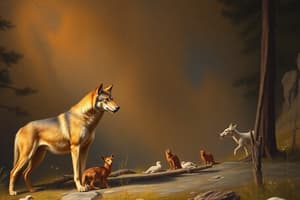Podcast
Questions and Answers
What was the main reason most reports of boiling mud, steaming rivers, and petrified trees were ignored?
What was the main reason most reports of boiling mud, steaming rivers, and petrified trees were ignored?
- The reports were made by unknown explorers
- They were thought to be exaggerated (correct)
- They were believed to be myths
- The reports were not supported by scientific evidence
What event hindered further organized explorations of the Yellowstone region in the 1860s?
What event hindered further organized explorations of the Yellowstone region in the 1860s?
- The construction of the transcontinental railroad
- The Mexican-American War
- The American Civil War (correct)
- The California Gold Rush
Who led the Washburn-Langford-Doane Expedition in 1870?
Who led the Washburn-Langford-Doane Expedition in 1870?
- Gustavus Doane
- Ferdinand V. Hayden
- Nathaniel P. Langford
- Henry Washburn (correct)
What was the outcome of Captain William F. Raynolds' 1859 expedition?
What was the outcome of Captain William F. Raynolds' 1859 expedition?
Who was the geologist who convinced Congress to make Yellowstone a national park?
Who was the geologist who convinced Congress to make Yellowstone a national park?
What was the name of the expedition that followed the Yellowstone River to Yellowstone Lake?
What was the name of the expedition that followed the Yellowstone River to Yellowstone Lake?
What was the purpose of the Washburn-Langford-Doane Expedition?
What was the purpose of the Washburn-Langford-Doane Expedition?
Who was the guide for Captain William F. Raynolds' 1859 expedition?
Who was the guide for Captain William F. Raynolds' 1859 expedition?
What is the origin of the name 'Yellow Stone'?
What is the origin of the name 'Yellow Stone'?
What is the approximate age of the obsidian point found in Gardiner, Montana?
What is the approximate age of the obsidian point found in Gardiner, Montana?
Which Native American tribe did Lewis and Clark encounter in present-day Montana in 1805?
Which Native American tribe did Lewis and Clark encounter in present-day Montana in 1805?
What did John Colter observe in the northeastern section of the park during the winter of 1807-1808?
What did John Colter observe in the northeastern section of the park during the winter of 1807-1808?
What is the name of the place that John Colter described after surviving wounds in 1809?
What is the name of the place that John Colter described after surviving wounds in 1809?
What was the primary use of the obsidian found in the park by the Paleo-Indians?
What was the primary use of the obsidian found in the park by the Paleo-Indians?
What was the result of the obsidian trade between local tribes and tribes farther east?
What was the result of the obsidian trade between local tribes and tribes farther east?
What was the approximate time period when Native Americans began to hunt and fish in the region?
What was the approximate time period when Native Americans began to hunt and fish in the region?
Flashcards are hidden until you start studying
Study Notes
Yellowstone National Park Naming
- The park gets its historical name from the Yellowstone River, which was named by French trappers as "Roche Jaune" (Yellow Stone).
- The name is likely a translation of the Hidatsa name "Mi tsi a-da-zi" (Yellow Stone River).
Native American History
- Human history in the park began at least 11,000 years ago with Native Americans hunting and fishing in the region.
- Paleo-Indians of the Clovis culture used obsidian from the park to make tools and weapons.
- Obsidian points made in the park have been found as far away as the Mississippi Valley, indicating a trade network between tribes.
Early Explorers
- John Colter, a member of the Lewis and Clark Expedition, was the first European American to explore the park in 1807-1808.
- Colter described a geothermal area in the northeastern part of the park, which was initially dismissed as delirium.
Early Reports and Exploration
- Reports of boiling mud, steaming rivers, and petrified trees in the park were largely ignored as myths until the late 1860s.
- Jim Bridger reported observing boiling springs and a mountain of glass and yellow rock in 1856, but his accounts were not believed due to his reputation as a "yarn spinner".
Organized Exploration
- Captain William F. Raynolds led a U.S. Army survey of the southern central Rockies in 1859, but was unable to cross the Continental Divide due to heavy snow.
- The Cook–Folsom–Peterson Expedition of 1869 was the first detailed expedition to the Yellowstone area.
- The Washburn–Langford–Doane Expedition of 1870 explored the region, collected specimens, and named sites of interest.
Ferdinand V. Hayden
- Hayden was an American geologist who convinced Congress to make Yellowstone a national park in 1872.
Studying That Suits You
Use AI to generate personalized quizzes and flashcards to suit your learning preferences.




